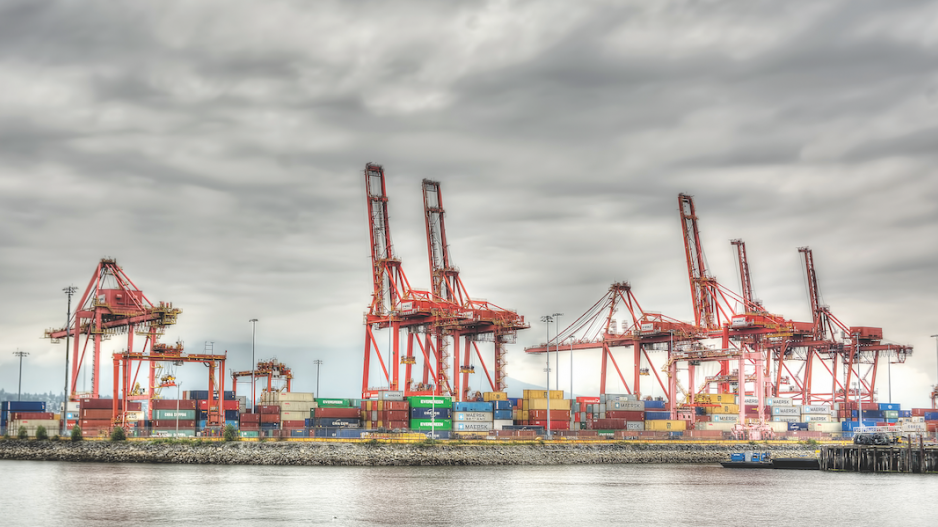Movement of goods through the Port of Vancouver increased a marginal 1% for 2020, a year in which global trade was beset by challenges posed by the COVID-19 pandemic.
Overall, cargo through the port increased to 145.5 million metric tonnes (MMT) from 144.2 MMT compared with 2019. Records were set for movement of grain, potash and containers.
Port president and CEO Robin Silvester said the lesson learned through 2020’s challenges is that infrastructure and continuing to build it is key to growth.
He said the port and all its moving parts and people have responded with resilience in the face of the worst recession since 1929.
Briefly put:
• container quantities increased 2% to 3.5 million 20-foot-equivalent unit (TEUs);
• imports increased 7% to 1.9 million TEUs;
• exports decreased 3% to 1.6 million TEUs;
• breakbulk cargo decreased 3% to 16.7 MMT;
• wood pulp increased 8%;
• basic metals decreased 12%;
• bulk dry cargo increased 1%;
• coal volumes decreased 15%;
• grain volumes were up 28%;
• potash was up 11%;
• sulphur was up 8%;
• bulk liquid increased by 16% over year-end 2019 due to an 18% increase in petroleum products and a 16% increase in canola oil; and
• the cruise season was cancelled in 2020.
Detailed cargo breakdowns can be found here.
Statistics show, for the fifth year in a row, global demand for Canadian grain resulted in a new annual record of 35.1 MMT of grain shipped both in bulk ships and containers, an increase of fully 24% or 6.8 MMT compared with 2019.
Increases in wheat were up 25%, canola up 45% and specialty crops up 12%.
Fertilizer inputs were also up with potash exports increasing by 11% from 2019’s record and sulphur increased by 8%.
Growth in total foreign exports resulted in a year-end record of 99 MMT, up 3% due to the increases in grain and fertilizers, as well as petroleum cargos.
Shipping container quantities saw record movement of 3.5 million TEUs, an increase of 2% compared with 2019.
However, cargo volumes in some sectors declined as a result of numerous challenges, including pandemic restrictions, railroad blockades, weather conditions and terminal upgrades.
Auto imports were down 18%, and export breakbulk forest products and coal were down, respectively, 14% and 15% from the previous year.
The port expects container demand to continue to grow and continue with co-operative infrastructure investment of more than $1 billion worth of infrastructure projects, including two container terminal projects and a number of road and rail infrastructure projects.
“By investing to build the necessary capacity to accommodate increasing trade growth, we are supporting all port users, including farmers, businesses, and industry who rely on the port to move their goods efficiently and remain competitive,” Silvester said. “This is critical to the long-term economic viability of this gateway and of Canada.”
A big piece of solving that growing puzzle is proceeding with the $3 billion Roberts Bank 2 container terminal project, Silvester said. Without that expansion, he said, the port would be over capacity and be forced to rely on U.S. ports.
The port results on grain traffic mesh with CN’s announcement March 2 of its 12th consecutive month of record-breaking grain movement, with 2.28 MMT of Canadian grain and processed grain products via carload in February.
That figure exceeds the previous February record set in 2019 of 2.12 MMT by over 7%.
So far, during the 2020-21 crop year, CN (TSX: CNR) (NYSE:CNI) has moved over 19.7 MMT of Canadian grain. This is 24% higher than the three-year average of 15.9 MMT and 17% higher than the record of 16.9 MMT set in the 2018-19 crop year.
The company said its continued ability to deliver record grain volumes as well as other commodities and goods is due to the investments in capacity made by the railroad in recent years.
Since 2018, the company said it has invested more than $10 billion in track, locomotives and railcars, including the purchase of over 2,500 new high-capacity grain hopper cars.
@jhainswo




